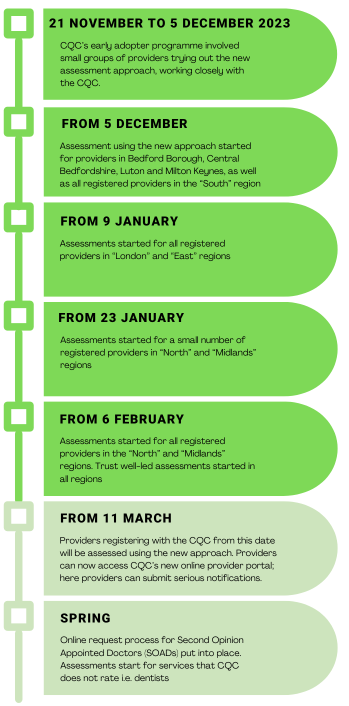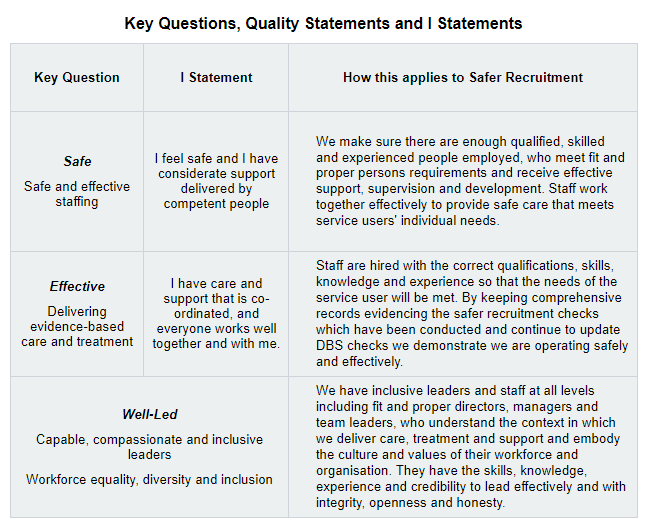New CQC updates: how ClouDoc is helping you stay compliant
In May 2021, to keep up with the evolving landscape of health and social care, CQC launched a new strategy which set out their ambitions for regulation in the future. The most notable aspect of this strategy years later has come into effect in the form of CQCs new regulatory approach.

Key differences between the old and new assessment approach
- Gathering evidence: CQC will make more use of information, including people’s experience of services. CQC will gather evidence to support their judgements in a variety of ways and at different times (not just through inspections).
- Frequency of assessments: CQC will no longer use the rating of a service as a main driver when deciding when the service needs to be assessed again. Evidence the CQC collect or recieve at any time can trigger an assessment.
- Assessing quality: CQC will make judgements about quality more regularly, instead of just after an inspection as they do currently. They will use a variety of evidence and use their updated quality statements to do so. CQC assessments will be more structured and transparent, using evidence categories and giving each category a score:
- People’s experience of health and care services “This is all types of evidence from people who have experience relating to a specific health or care service, or a pathway across services. It also includes evidence from families, carers and advocates for people who use services.”
- Feedback from staff and leaders “This is evidence from people who work in a service, local authority or integrated care system, and groups of staff involved in providing care to people.”
- Feedback from partners “This is evidence from people representing organisations that interact with the service or organisation that is being assessed.”
- Observation “Observing care and the care environment will remain an important way to assess quality.”
- Processes “Processes are the series of steps, arrangements or activities that a provider or organisation carries out to deliver safe care that meets people’s needs.”
- Outcomes “Outcomes are focused on the impact of care processes on individuals. They cover how care has affected people’s physical, functional or psychological status.”
Also see: “Section 4: Which evidence categories we prioritise for your sector“
CQC’s new assessment framework gives them the flexibility to:
- update the ratings for key questions and overall ratings when things change, based on more frequent assessment of evidence
- collect and review evidence in some categories more often than others. For example, they may collect evidence of people’s experiences more often than evidence about processes
- be selective in which quality statements they look at – this could be one, several or all.
New assessment approach with emphasis on the experience of service users
CQC have refocused the emphasis on service user experience in their new assessment approach, to following one of their strategic measures:
“We have set a clear definition of quality and safety based on what people say matters to them, and this is used consistently by people who use services, and at all levels of health and social care.”
The CQC has implemented service user experience into their new single assessment framework with the introduction of ‘I statements’ which they have linked to each quality statement. These ‘I statements’ were developed via the Making It Real Framework, co-produced by Think Local Act Personal (TILAP) and focus on the lived experience of people using health and care services.
These I statements are now part of CQC’s assessment framework as they reflect what people using services have said matters to them. CQC are also looking to develop tools and techniques that use the I statements to help gather evidence for assessments e.g. in focus groups, interviews and case tracking.
ClouDoc has implemented I statements into the quality standards at the top of your registry policies, and will be further introducing them for every CQC document. Keep an eye out for updates on your documents, the updated quality statements table format looks like this –

CQC's new online provider portal
From 11 March all providers can sign up to CQC’s new portal. This new portal will allow providers to update and track their registry activity.
Other benefits include:
- A faster experience for providers
- Pre-Completed information about your service (e.g. location IDs)
- Ability to save drafts
- Progress updates on registry/notifications
- Ability to view your service’s submission history
- Automatic check to see if information is entered correctly (less need for follow up contact from CQC)
Registered providers will be able to submit serious notifications using the portal, serious notifications include:
- SN16: Death of a person using the service
- SN17: Death of a detained mental health patient
- SN18: Allegations of abuse
- SN18: Outcome of an application to deprive a person of their liberty (DoLS)
- SN18: Events that stop a service running safely or properly
- SN18: Police involvement in an incident
- SN18: Serious injury to a person using a service
The ClouDoc team is keeping track of any updates related to the new provider portal that may affect documents. Once the portal is finalised, documents related to safeguarding / serious notifications will be updated to include references and link to the online portal. ClouDoc is committed to keeping your documents up-to-date and in compliance with any CQC changes; keep an eye out for updates!
If you have any questions, don’t hesitate to contact us on 0330 808 0050 or email support@cloudoc.co.uk



